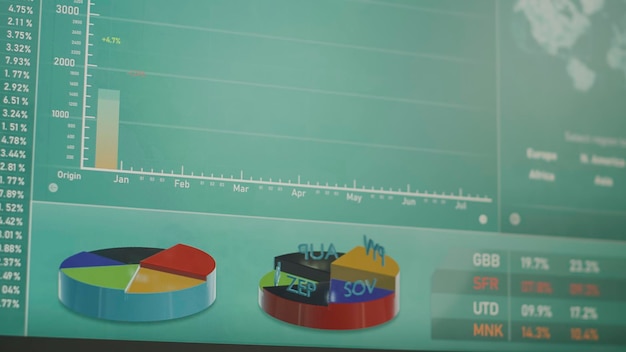Investing in Index Funds: A Beginner’s Guide for US Investors

Investing in index funds is a straightforward and cost-effective strategy, especially for beginners, offering diversification and long-term growth potential with minimal effort.
Starting your investment journey can be overwhelming, but it doesn’t have to be. Investing in index funds provides a simple and accessible way to build wealth over time. This guide will walk you through the basics, helping you understand how index funds work and how they can fit into your investment strategy.
Understanding Index Funds: The Basics
Index funds are a type of mutual fund or exchange-traded fund (ETF) designed to track a specific market index, such as the S&P 500. This means the fund’s holdings mirror the index’s composition, providing instant diversification across a broad range of stocks or bonds. For beginners, this is a less risky entry point compared to picking individual stocks.
Think of it like this: Instead of trying to select the “best” companies, you’re buying a little bit of everything. This approach significantly reduces the risk associated with individual stock performance, as the fund’s overall performance is tied to the performance of the entire index.
What is a Market Index?
A market index is a benchmark that represents the performance of a specific market segment. The S&P 500, for example, tracks the performance of 500 of the largest publicly traded companies in the United States. Other common indexes include the Nasdaq Composite and the Dow Jones Industrial Average.
- S&P 500: Tracks 500 of the largest publicly traded US companies.
- Nasdaq Composite: Focuses on technology and growth stocks.
- Dow Jones Industrial Average: An older index tracking 30 large US companies.
Choosing the right index fund involves understanding which market segment you want to invest in. Do you want broad exposure to the US stock market? The S&P 500 is a good choice. Are you interested in technology stocks? The Nasdaq Composite might be more suitable. Consider your investment goals and risk tolerance when making this decision.
In essence, index funds offer a simple, diversified, and relatively low-cost way to participate in the stock market. By tracking a specific index, they eliminate the need for active management, which translates to lower fees and a more predictable investment outcome.
Why Choose Index Funds? The Benefits
Investing in index funds offers several key advantages, particularly for those new to the world of investing. These benefits include diversification, low costs, tax efficiency, and simplicity. Understanding these advantages can help you make an informed decision about whether index funds are the right choice for your investment goals.
One of the most compelling reasons to choose index funds is their ability to provide instant diversification. This means you’re spreading your investment across a wide range of companies, reducing the impact of any single company’s performance on your overall portfolio.
Diversification Explained
Diversification is a risk management technique that involves spreading your investments across different asset classes, industries, and geographic regions. By diversifying your portfolio, you can reduce the risk of losing money if one investment performs poorly. Index funds offer built-in diversification, as they track a broad market index containing hundreds or even thousands of different securities.
Low costs are another significant advantage of index funds. Because these funds are passively managed, meaning they simply track a specific index, they have lower expense ratios compared to actively managed funds. These lower fees can have a substantial impact on your long-term investment returns.
Furthermore, index funds are generally more tax-efficient than actively managed funds. This is because they have lower turnover rates, meaning they buy and sell securities less frequently. This lower turnover rate results in fewer taxable events, such as capital gains distributions, which can help you minimize your tax burden.
In conclusion, the benefits of investing in index funds, including broad diversification, low costs, and tax efficiency, make them an attractive option for both beginner and experienced investors alike. They provide a simple and effective way to build a diversified portfolio and achieve your long-term financial goals.

Getting Started: Opening a Brokerage Account
Before you can start investing in index funds, you’ll need to open a brokerage account. This account will serve as the platform through which you buy and sell investments. Choosing the right brokerage is an important first step, so consider factors like fees, investment options, and user-friendliness.
Numerous online brokers cater to beginners, offering commission-free trading and user-friendly interfaces. Research and compare different brokers to find one that aligns with your needs and preferences. Some popular options include Vanguard, Fidelity, and Charles Schwab.
Choosing a Brokerage Firm
When selecting a brokerage, pay attention to the following:
- Fees: Look for brokers that offer commission-free trading on index funds and ETFs.
- Investment Options: Ensure the broker offers a wide range of index funds to choose from.
- Account Minimums: Some brokers may require a minimum account balance to open an account.
Once you’ve chosen a brokerage, the process of opening an account is typically straightforward and done online. You’ll need to provide personal information, such as your Social Security number and address, and answer questions about your investment goals and risk tolerance. The brokerage may also require you to verify your identity by uploading a copy of your driver’s license or other government-issued ID.
After your account is approved, you’ll need to fund it. You can typically do this through an electronic bank transfer, check, or wire transfer. Once your account is funded, you’ll be ready to start buying index funds.
Opening a brokerage account is a crucial first step in your investment journey. By carefully considering your options and choosing a broker that meets your needs, you can set yourself up for success in the world of index fund investing.
Selecting the Right Index Funds
Choosing the right index funds involves considering factors like expense ratios, tracking error, and the specific index the fund tracks. Lower expense ratios and minimal tracking error are generally desirable, as they indicate that the fund is efficiently managed and closely mirrors the performance of its target index.
One of the key considerations when selecting an index fund is understanding its expense ratio. The expense ratio is the annual fee charged by the fund to cover its operating expenses. This fee is expressed as a percentage of your investment and can significantly impact your long-term returns.
Understanding Expense Ratios
Expense ratios can range from as low as 0.03% for some broad market index funds to over 1% for more specialized or actively managed funds. Over time, even small differences in expense ratios can add up, so it’s important to choose funds with low expense ratios whenever possible.
Another important factor to consider is tracking error. Tracking error measures how closely the fund’s performance matches the performance of its target index. Ideally, an index fund should have minimal tracking error, indicating that it is effectively replicating the index’s holdings and performance.
- Expense Ratio: The annual fee charged by the fund.
- Tracking Error: How closely the fund matches its target index.
- Index Choice: Ensure the index aligns with your investment goals.
In addition to expense ratios and tracking error, you should also consider the specific index the fund tracks. Make sure the index aligns with your investment goals and risk tolerance. For example, if you’re looking for broad exposure to the US stock market, you might choose an index fund that tracks the S&P 500. If you’re interested in international stocks, you might choose an index fund that tracks a global stock market index.
Ultimately, selecting the right index funds requires careful research and consideration. By understanding factors like expense ratios, tracking error, and index choice, you can build a well-diversified portfolio that aligns with your investment goals and helps you achieve your desired financial outcomes.
Building a Diversified Portfolio with Index Funds
Creating a diversified portfolio involves allocating your investments across different asset classes, such as stocks, bonds, and real estate. Index funds can be used to easily achieve diversification within each asset class, allowing you to build a well-rounded portfolio that aligns with your risk tolerance and investment goals.
A common approach to building a diversified portfolio with index funds is to use a “three-fund portfolio.” This portfolio typically consists of a US stock market index fund, an international stock market index fund, and a bond market index fund. The allocation between these three funds will depend on your individual circumstances and risk tolerance.

The Three-Fund Portfolio
The three-fund portfolio is a simple yet effective way to achieve diversification with index funds. By investing in a broad range of asset classes, you can reduce the risk of losing money if one investment performs poorly.
As you get closer to retirement, you may want to shift your asset allocation to become more conservative, reducing your exposure to stocks and increasing your exposure to bonds. This can help protect your portfolio from market volatility and ensure you have enough income to support your retirement years.
Rebalancing is also an important part of managing a diversified portfolio. Over time, the performance of your different investments will cause your asset allocation to drift away from your target allocation. Rebalancing involves buying and selling assets to bring your portfolio back to its original allocation.
- US Stocks: Provide growth potential.
- International Stocks: Offer diversification beyond the US market.
- Bonds: Provide stability and income.
In summary, building a diversified portfolio with index funds is a straightforward and effective way to manage risk and achieve your investment goals. While professional financial advice is beneficial, it is still possible to achieve a good ROI through Index Funds
Long-Term Investing Strategies
Success in investing often comes down to adopting a long-term perspective and sticking to a well-defined investment strategy. One popular strategy for long-term investing is dollar-cost averaging, which involves investing a fixed amount of money at regular intervals, regardless of market conditions. This can help reduce the impact of market volatility on your investment returns.
The key to successful long-term investing is to remain disciplined and avoid making emotional decisions based on short-term market fluctuations. Market downturns can be scary, but they also present opportunities to buy investments at lower prices.
Dollar-Cost Averaging
Dollar-cost averaging is a strategy that can help you take the emotion out of investing. By investing a fixed amount of money at regular intervals, you’re automatically buying more shares when prices are low and fewer shares when prices are high.
Another important aspect of long-term investing is to regularly review your portfolio and make adjustments as needed. Your investment goals and risk tolerance may change over time, so it’s important to ensure your portfolio continues to align with your needs and circumstances.
Consider automating your investments to ensure you’re consistently contributing to your portfolio. Many brokerages offer automatic investment plans that allow you to set up regular transfers from your bank account to your investment account.
Finally, remember that investing is a marathon, not a sprint. There will be ups and downs along the way, but by staying disciplined, remaining focused on your long-term goals, and avoiding emotional decisions, you can increase your chances of achieving financial success.
| Key Point | Brief Description |
|---|---|
| 💰 Diversification | Spreading investments across many companies lowers risk. |
| 💸 Low Costs | Index funds have lower fees than actively managed funds. |
| 📈 Long-Term | Stay invested through market ups and downs for growth. |
| 📊 Rebalancing | Adjust your portfolio periodically to maintain your asset allocation. |
Frequently Asked Questions
▼
An index fund is a type of investment that holds all the stocks or bonds in a specific market index, like the S&P 500, aiming to mirror its performance with minimal management.
▼
You can purchase shares of an index fund through a brokerage account. Once opened and funded, you can search for the ticker symbol of the desired fund and buy shares.
▼
The primary benefits include instant diversification, lower costs compared to actively managed funds, and historically competitive long-term returns mirroring the index’s performance.
▼
Rebalancing your portfolio every 6 to 12 months can help maintain your desired asset allocation, ensuring your investments align with your risk tolerance and financial goals.
▼
Index funds are generally suitable for most investors, especially those seeking a simple, diversified, and cost-effective way to invest for the long term and grow their wealth.
Conclusion
Investing in index funds can be a powerful tool for building wealth, especially for beginners. By understanding the basics, opening a brokerage account, selecting the right funds, building a diversified portfolio, and adopting a long-term perspective, you can set yourself up for financial success. Remember to stay disciplined, avoid emotional decisions, and regularly review your portfolio to ensure it continues to align with your goals.





